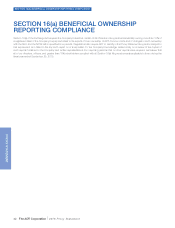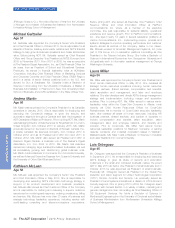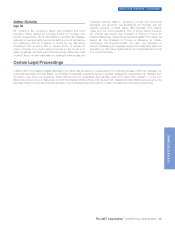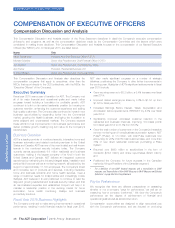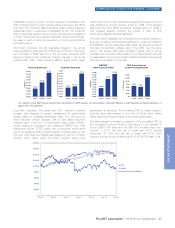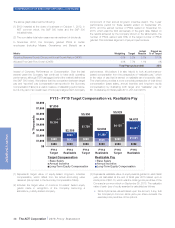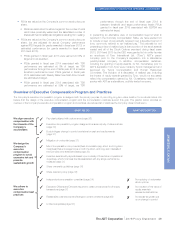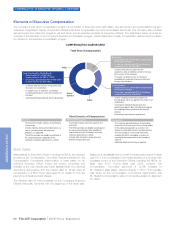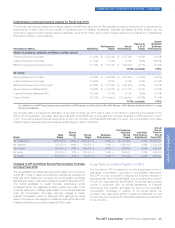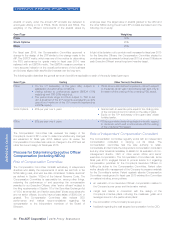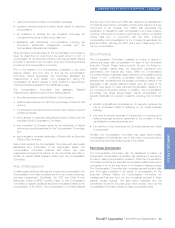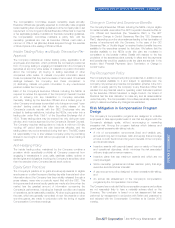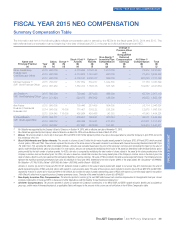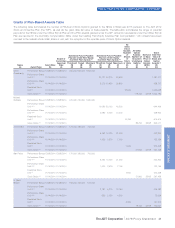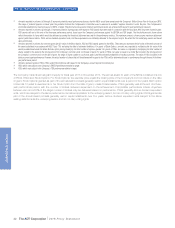ADT 2015 Annual Report Download - page 42
Download and view the complete annual report
Please find page 42 of the 2015 ADT annual report below. You can navigate through the pages in the report by either clicking on the pages listed below, or by using the keyword search tool below to find specific information within the annual report.
COMPENSATION OF EXECUTIVE OFFICERS—CONTINUED
What was changed from Fiscal Year 2014 Why changes were made for Fiscal Year 2015
Replaced the Steady-State Free Cash Flow (“SSFCF”) metric with
EBITDA
•We believe that EBITDA captures a greater level of impact of the
value drivers of the Company’s business than SSFCF.
•We exclude special items in order to eliminate the impact of
items management believes are not indicative of the
Company’s core operating performance.
•EBITDA is a more commonly utilized metric in incentive plans in
our peer group and the broader market, and is more easily
understood by both investors and plan participants.
Repositioned the Net Attrition metric as a Customer Retention metric
(the inverse of Net Attrition)
•We believe that Customer Retention provides the Company’s
employees with a stronger positive focus of increasing the
number of customers retained compared to the positioning as a
Net Attrition metric, where messaging is focused on reducing
the number of customers lost.
Eliminated the concept of Strategic Modifiers and introduced Business
Unit-level metrics for those employees (including certain of the
Company’s Executive Officers) who support one of the Company’s
Business Units, while maintaining a level of alignment to overall
corporate results
•50% of the funding of the annual incentive for employees
supporting one of the Company’s Business Units is aligned to the
results of the Business Unit, with the other 50% of the funding
aligned to overall corporate results
•The Strategic Modifiers in place in fiscal year 2014 were
intended to focus on growth in the Company’s Small Business
channel and on controlling the costs related to serving
customers. The introduction of Business Unit-level metrics
across all of the Company’s Business Units is intended to focus
employees on driving results which they have more ability to
impact within their respective Business Unit, while still
maintaining the focus on the results of the Company as a whole.
•The introduction of the EBITDA before special items (Corporate)
metric is intended to focus attention on controlling costs across
the organization, eliminating the need for the Recurring Revenue
Margin modifier.
Eliminated the individual objective component from the plan design
and replaced with an individual performance modifier
•This change was designed to focus participants in both the
Officer Bonus Plan and the AIP on overall Company (and, as
applicable, Business Unit) results as the funding mechanism for
annual incentives. The individual performance modifier allows
management to recognize individual contributions to the overall
results by adjusting incentives for individual participants up or
down within the overall pool. For participants in the Officer
Bonus Plan, the individual performance modifier is limited to
+/-20% of their incentive target (as adjusted for business
performance).
For fiscal year 2015, the funding of annual incentive awards for Messrs. Gursahaney, Geltzeiler and Bleisch and Ms. DeVard was based solely
on overall corporate results. For Mr. Ferber, President of the Residential Business Unit, and other participants in the AIP who support the
Residential Business Unit, the funding of annual incentive awards was based on both overall corporate results and the results of the Residential
Business Unit. For the Residential Business Unit, the Business Unit-specific metric noted in the plan design chart above was Creation Multiple,
which is a metric that measures the length of time in months, on average, it takes the Company to break even on its investment in acquiring a
customer account.
32 The ADT Corporation 2016 Proxy Statement
PROXY STATEMENT


